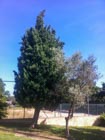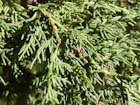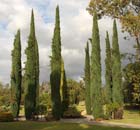
Fruits on a tree in habitat growing in Mut, Turkey [Leo Goudzwaard, 2007].

A fastigiate form tree in La Gavotte (near Marseille), France [Franck Miguel, 2017.07].

An adjacent horizontal form tree in La Gavotte (near Marseille), France [Franck Miguel, 2017.07].

Foliage on an ornamental, Seattle arboretum [C.J. Earle].

Distribution of C. sempervirens within Europe, North Africa, and West Asia, based on map from GBIF.org downloaded on 2023.01.01. Red dots are observations from within countries thought to be within the species' native range, based on Farjon (2010). Other dots are inferred to represent naturalized occurrences, though some may be misclassified plantings. The same source shows other naturalized occurrences in Argentina, Australia, Azores, Bolivia, Brazil, Cape Verde Islands, Chile, China, Colombia, Dominican Republic, El Salvador, Ghana, Haiti, Honduras, India, Indonesia, Iraq, Jamaica, Japan, Martinique, Mauritius, Mexico, Mozambique, New Zealand, Peru, South Africa, Taiwan, and the USA.

This species is a popular ornamental, with many cultivars available; this is "stricta" [C.J. Earle, 2009.12.06, at the Los Angeles Arboretum].

Conservation Status

Cupressus sempervirens
Linnaeus 1753, p. 1002
Common names
Mediterranean cypress, common cypress, Italian cypress; sarv-e [Persian].
Taxonomic notes
Synonymy (Farjon 2005):
- Cupressus horizontalis Mill. 1768;
- Cupressus sempervirens L. var. horizontalis (Mill.) Loudon 1830;
- Cupressus sempervirens L. f. horizontalis (Mill.) Voss 1907;
- Cupressus sempervirens L. subsp. horizontalis (Mill.) A. Camus 1914;
- Cupressus patula Spadoni 1826;
- Cupressus horizontalis Mill. var. pendula hort. ex Endl. 1847;
- Cupressus sempervirens L. var. numidica Trab. 1913.
Many authors have recognized that the species broadly assumes two growth habits, fastigiate or horizontal, and have assigned subspecific taxonomic ranks on that basis. It is widely thought that only the horizontal form predates human activity, with the fastigiate form having a horticultural origin dating to early historic or prehistoric times. Thus it is a cultivar, not a variety or subspecies. There is also some question as to whether the fastigiate form is strictly heritable; it appears that "horizontal" specimens may arise from "fastigiate" stock (Stankov 1999, Farjon 2005).
Description
"A tree 20-30 m in height. Trunk straight. Bark thin, smooth and gray for quite a long time, later becoming gray-brown and longitudinally furrowed. Shoots radiating in all directions, about 1 mm in diameter, round or quadrangular. Leaves scale-like, decussate, small, ovate, obtuse, dark green, with a dorsal gland in the shape of longitudinal furrow. Flowers appear early in spring. Cones on short stalk, glossy, brown to gray, pendulous, globose to elliptic, 2-3 cm long, composed of 8 to 14 opposite scales, with concave to flat apophysis, with a small central umbo and a point. Seeds 8-20 to each fertile scale, brown, flattened, minute, without resin blisters, narrowly winged. Cotyledons usually 2" (Vidakovic 1991). See García Esteban et al. (2004) for a detailed characterization of the wood anatomy.
Cones begin to open in September. After shedding the seeds, the cone persists on the tree for several years because, as with many species of Cupressus, C. sempervirens displays varying levels of serotiny: cones may remain unopened on the tree for many years until a fire induces them to open and subsequently to shed viable seed (Vidakovic 1991).
Distribution and Ecology
Due to the long horticultural history of this species in the Mediterranean region, its original native distribution is unclear; perhaps the question is pointless, as widespread human alteration of natural environments in the region has occurred across a time span featuring substantial climate changes. Various authorities attribute its native distribution to Crete, Greece (some Aegean islands), Iran, Israel, Jordan, Lebanon, Libya, Syria, and Turkey; and perhaps Cyprus (which would only be appropriate) (Dinets 1998, Farjon 2010, Stankov 1999, Vidakovic 1991). See map and caption at right regarding its naturalized distribution.
It is tolerant to temperatures as low as -20°C (Tucovic 1956, Raddi and Panconesi 1989), but Bannister and Neuner (2001) rate it hardy to Zone 7 (cold hardiness limit between -17.7°C and -12.2°C). "This species is also tolerant to drought, air currents, wind dust, sleet and atmospheric gases. Its root system is well developed. It succeeds on acid and alkaline soils" (Vidakovic 1991).
Remarkable Specimens
The largest reported specimens within the species' native range can be found in the Lefka Ori (Greek for White Mountains) of Western Crete. In the National Park "Samaria Gorge" trees grow to approximately 30-33 m high and 1 m dbh. These trees may have been planted in ancient times. In native stands a big tree would be some 20-25 m tall and 50 cm dbh (Stankov 1999). The largest trees are probably old horticultural specimens that have received ample water and nutrients. The most extraordinary of these is the سرو ابرکوه Sarv-e Abarku in Abarkuh, Iran; in 2016, this multi-trunked tree was approximately 573 cm dbh and 25 m tall (Monumental Trees 2023). Another large tree, with a dbh of 182 cm and height of 15 m, grows in Campestri, Tuscany (Corpo Forestale Della Stato 1999), and another Tuscan tree (Firenze, FI: Villa della Petraia) has been measured at 30 m tall and 172 cm dbh (Stankov 1999). Similarly, the tallest specimens appear to be in cultivation; a tree 42.2 m tall (2014 laser measurement) grows on private land in Takaka, New Zealand (New Zealand Tree Register, 2020). A tree 38.1 m tall has been measured at the Casa de Labrador in Aranjuez, Spain (Árboles Singulares de Madrid 2013).
Vidakovic (1991) says it "attains up to 1000 years of age" but provides no supporting evidence. This is another of the many species for which extraordinary ages have been attributed (at least one is claimed to exceed 4,000 years) on the basis of no evidence. The problem includes the widespread planting of trees in sacred spaces, where trees often attain extraordinary sizes due to ample water and horticultural care, and where it is typical for a dead tree to be replaced; after a few years (or centuries) the replacement event is forgotten and the age of the tree becomes apocryphal. Nonetheless, it would not be surprising for the species to exceed 1,000 years of age; many Cupressus species do so.
Ethnobotany
The tree has religious significance, e.g. to the Zoroastrians of Iran, who have a story that a sapling was brought from Paradise by Zoroaster himself. Many exceptionally large individual trees are protected in Iran, perhaps in part because of this belief; for much more detail on the species' importance in classical Persian art and culture, see the Encyclopedia Iranica (2011). This species is a common ornamental, planted around the world. The "[w]ood is durable and easily worked" (Vidakovic 1991), and the species has been planted for timber production, particularly in South America, Africa, and New Zealand (Stankov 1999).
In Italy, its use has been explored for both archeological dating and dendroclimatic reconstruction (Corona 1970). It has frequently been used in archeological dating in Israel (e.g., Liphschitz et al. 1981).
Observations
See Big tree, above. Can also be seen in nearly any subtropical or temperate arboretum.
Remarks
The epithet sempervirens means "always green." This epithet has only been applied to three conifers, indicating that conifer taxonomists are more imaginative than they are usually given credit for.
"A full crop of seed occurs every year. Germination energy is high and germination lasts for several years. Due to aromatic oils, the seeds are fragrant, especially when crushed. In 1 kg there are up to 150,000 seeds... Fast-growing when young, it begins producing seed in its tenth year. In addition to seeds, it may be propagated by grafting, cuttings and coppice shoots" (Vidakovic 1991).
Citations
Árboles Singulares de Madrid. 2013.06.23. Blog entry at arbolessingularesmadrid.blogspot.com.es/2010/06/cipres-de-la-real-casa-del-labrador.html, accessed 2016.11.05.
Atlas Florae Europaeae. 1998. Computer program formerly available for download at http://www.fmnh.helsinki.fi/english/botany/afe/index.htm, accessed 2009.04.17, now defunct.
Corona, E. 1970. Valore dendrocronologico del cipresso sempreverde. [The value of Cupressus semperivens for dendrochronology.] Monti e Boschi 21(5): 21-25 [in Italian with English summary].
Corpo Forestale Della Stato. 1999. http://www.corpoforestale.it/aes/Ricerca/alberi_m/index.htm, accessed 1999.10.01, now defunct.
Dinets, Vladimir. E-mail, 1998.01.12.
Encyclopedia Iranica. 2011. Cypress. https://www.iranicaonline.org/articles/cypress-sarv-cupressus-tourn, accessed 2023.10.26.
Liphschitz, N., Lev-Yadun, S., Waisel, Y. 1981. Dendroarchaeological investigations in Israel (Masada). Israel Exploration Journal 31(3-4): 230-234.
Monumental Trees. 2023. Mediterranean Cypress Sarv-e Abarqu in Abarkuh, Yazd, Iran.
https://www.monumentaltrees.com/en/irn/yazd/abarkuh/2941_sarveabarqu/, accessed 2023.10.26.
Raddi, P. and A. Panconesi. 1989. Genetic variability of tolerance to cold in Cupressus sempervirens progenies. Silvae Genetica 38(5-6):168-172.
Stankov, Hristo Dimitrov. E-mail, 30-Jun-1999.
Tucovic, A. 1956. Cempres - Cupressus sempervirens L. u Beogradu. Sumarstvo 1-2: 45-52.
See also
Adams, R. P., T. Mataraci, S. Gucel, and J. A. Bartel. 2017. Comparison of leaf essential oils of fastigiate (strict) and horizontal forms of Cupressus sempervirens from Cyprus, Montenegro, Turkey, and United States. Phytologia 99(1): 48-53.
Elwes and Henry 1906-1913 at the Biodiversity Heritage Library. This series of volumes, privately printed, provides some of the most engaging descriptions of conifers ever published. Although they only treat species cultivated in the U.K. and Ireland, and the taxonomy is a bit dated, still these accounts are thorough, treating such topics as species description, range, varieties, exceptionally old or tall specimens, remarkable trees, and cultivation. Despite being over a century old, they are generally accurate, and are illustrated with some remarkable photographs and lithographs.
Farjon (2005) provides a detailed account, with illustrations.






